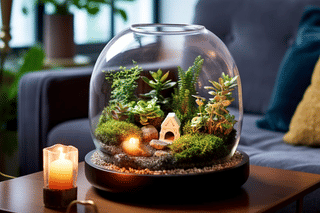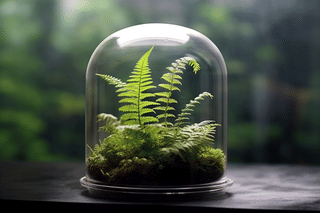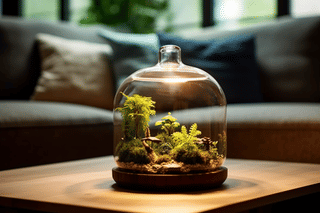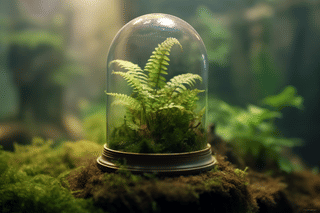Best Plants for Your Terrarium: A Comprehensive Guide
Looking to make a terrarium but not sure where to start? This beginner's guide has got you covered! Learn all the basics of how to create a mini garden in a jar, including plant selection, common problems, and more. Follow these step-by-step instructions and have fun!
Have you ever wanted to create your own little world inside a glass jar, a tiny forest or jungle that you can keep on your desk or in your living room? Welcome to the magical world of terrariums!
Terrariums are like miniature gardens in a small glass environment. They're perfect for people who love plants but don't have a lot of space, or for those who want to bring a bit of nature indoors. The best part? Terrarium plants require very little maintenance.
This comprehensive guide will walk you through everything you need to know to choose the best plants for your terrarium. We'll look at the types of plants that thrive in this unique environment and how to care for them to keep your mini-garden healthy and happy.
These are the topics we're going to look at:
So, are you ready to get started on your terrarium journey? Let's get started!
What is a Terrarium?
A terrarium is your mini indoor garden, enclosed in a glass container. These glass containers can be as small as a small pickle jar or as large as a fish aquarium. A terrarium doesn't just look great and adds a unique decoration to any living space, but it also provides a perfect environment for certain plants to thrive. A terrarium is a micro-ecosystem where moisture-loving plants can enjoy a humid environment.
The closed-off glass jar traps all moisture from the soil and the plant and it causes the glass jar to act like a small greenhouse. It's very humid. This also makes terrariums so low-maintenance. If you never open the container, you never have to water your plant. The moisture stays in the container and constantly waters your plant for you.
Terrariums might look like tricky growing environments, but they're easy to maintain. This makes them perfect for those who love plants but either forget to take care of their plants or simply don't have time. But the big question is, can you grow any plant in a terrarium?
Can You Grow Any Plant in a Terrarium?
I've been keeping several plants in terrariums for years and have watered them a handful of times after removing dead plants and algae. Terrariums are incredible, but can you grow any plant in one?
Terrariums provide a unique and sustainable ecosystem for plants, but it's important to realize that not every plant is a good fit to grow in a terrarium. The enclosed space and the unique humidity level in a terrarium make it an ideal environment for moisture-loving plants.
Species that love damp, shady environments, such as ferns, mosses, and certain types of orchids and air plants, are perfect for terrariums. They thrive in the humid conditions created by the closed terrarium.
Plants that are used to dry conditions, such as succulents and cacti, are not a good fit for these enclosed terrariums. Similarly, larger plants that grow quickly should also be avoided, as they may outgrow the space and suffocate other plants.
Does that mean you can't grow dry plants like succulents and cacti in a terrarium? They still can, but you need to make sure that the terrarium isn't completely closed off. The moisture needs to be able to escape the glass jar. Open terrariums are still a great place to grow these dry plants.
How do you choose the best plants for a terrarium?
When setting up your terrarium, picking the right plants is important. Picking the perfect plant is more than just picking out what looks good. You also need to look a little closer at the plant's natural habitat, its size, and the speed at which it grows. Let's learn more about this.
Look at a plant's natural habitat
Each plant has a unique natural habitat. When it comes to designing a terrarium, this habitat makes a huge difference. You want plants that thrive in high humidity and low to medium lighting since this is what the plant will get in your terrarium. Tropical plants, such as mosses and ferns, are often a perfect choice. They naturally thrive under trees in the forest where there's a lot of moisture and very little direct sunlight.
Consider the size and growth rate of plants
The size of your terrarium will also determine the plants you choose. You don't want a plant that's going to outgrow its container too quickly. Slower-growing plants or ones that stay small are your best bet. Ivys, begonias, and succulents are great examples of these types of plants.
Be careful with plants that grow quickly. While it might be great to see fast growth early on, these fast-growing plants can quickly take over your terrarium, squeezing out slow-growing plants and throwing off your mini-ecosystems balance.
The Best Plants to Grow in a Terrarium
Now that you know a little bit more about choosing the right plant for your terrarium, let's look at a few plants for the different sizes of terrariums. Choosing the right plants for your terrarium is important for its successful growth. Let's dive in and look at some of the best small, medium, and large plants to grow in a terrarium.
Best Small Terrarium Plants
If you're looking for the perfect plant to fit in your small terrarium, you've got some amazing options! These plants stay small and thrive in the conditions of a terrarium. Here are a few of my favorite plants to add to a small terrarium:
- Mosses: There are many types of mosses, and they are excellent as base plants in a terrarium. They're low-maintenance and love the humidity.
- Air plants (Tillandsia): These are plants that don't need soil to grow, and they come in a variety of sizes and shapes.
- Baby tears (Soleirolia soleirolii): This is a vibrant, fast-growing plant that creates a lovely green carpet, perfect for any terrarium. It's important to regularly prune this plant in your terrarium, because it will quickly take over the pot, pushing out other plants.
Top Medium-Sized Terrarium Plants
Are you looking for slightly larger plants to put in your terrarium but can't decide what kind to get? This list is for you! These options are not only beautiful, but they'll be super easy to take care of. Here are some of my recommendations:
- Nerve Plants (Fittonia): These plants offer colorful foliage and can make a great visual impact.
- Spiderwort (Tradescantia zebrina): Great for a tropical terrarium. They enjoy high humidity and indirect light.
- Polka Dot Plant (Hypoestes phyllostachya): Named for the bright spots that cover its leaves, this plant adds a burst of color to your terrarium.
These plants should all be pruned at least once per year, as they will slowly start to outgrow the container. By pruning them, you can give other plants a chance to grow as well. These plants aren't fast-growing though, so pruning them once per year is plenty.
Best Large Terrarium Plants
Finally, if you have room for a little extra growth in your terrarium, then you can get one or more larger plants! There are a few amazing options available if you're looking to get a few plants for your large terrarium:
- Maidenhair Fern (Adiantum): Not only do these ferns look stunning, but they also thrive in humid environments like terrariums.
- Peace Lily (Spathiphyllum): This plant has beautiful white blossoms and is easy enough to care for in a terrarium.
- Snake Plant (Sansevieria): Snake plants are a popular choice for desert-style terrariums with their vertical leaves. And they're easy to care for too! A desert terrarium has lots of ventilation and sandy soil. Perfect for those drought-loving houseplants.
You should now have a few plants to pick from for your terrarium, but how do you take care of them? Let's have a look!
How do you care for plants in a terrarium?
Caring for plants in a terrarium might seem complicated, but in my experience, taking care of plants in a terrarium is a breeze. Let's explore step-by-step how you should water them, the ideal light conditions they need, and their humidity preferences.
How do you water terrarium plants?
When it comes to watering, terrarium plants are a bit special. That's because the water stays in the closed environment of the terrarium, instead of evaporating away or draining like in a normal pot. So, it's very important to water them sparingly.
I usually recommend against watering your plants with a spray bottle, because it doesn't allow the moisture to reach your plant's roots. However, I think it's the ideal way to water plants in a closed terrarium.
The very first time you water your plants in a terrarium is the most difficult one. When you've planted your plants, make sure to spray them thoroughly so the top of the soil is moist. Then close the terrarium and monitor it for a few days. During the day, you should see a few drops of water on the inside of the glass, but if it's so wet that you can't see your plant properly, you've added too much water.
If you've added too much water, simply open the terrarium for 5-10 minutes and close it off again. This allows the excess moisture to evaporate from the container.
If you keep your container closed, you won't have to water your plant anymore. At all. However, as soon as you open the container to clean up a little, you'll need to use your spray bottle to replace some of the evaporated moisture.
The fact that you never have to water your plants in a closed terrarium seems wrong, but this makes it such a great option for low-maintenance plants.
What is the ideal light for terrarium plants?
Light is an important part of growing healthy terrarium plants. Most terrarium plants thrive in indirect light, meaning they don't want the sun's rays directly hitting them. This is especially true of plants growing in a terrarium.
Avoid placing your terrarium under direct sunlight as this can cause the temperature inside the terrarium to go up quite quickly, like in a greenhouse. This could damage your plants. Direct sunlight also causes algae to start growing in the warm and humid environment inside the terrarium.
Instead, put your terrarium in a well-lit area that gets a lot of light, but out of the sun's direct path.
Humidity preferences of terrarium plants?
And then the last important thing to look at: humidity. Terrariums are like small jungles, which means they often need a higher humidity level.
Closed terrariums create their humidity as water from the plants and soil evaporates, condenses, and falls back down like a mini rain cycle. However, in open terrariums, you might need to mist the plants lightly to maintain a decent humidity level.
For the best results, I recommend using a closed terrarium for moisture-loving plants and an open terrarium for drought-loving plants.
Common issues with terrarium plants
Terrarium plants might be easy to care for, but unfortunately, this doesn't mean they don't face any issues. Like all plants, they can sometimes run into problems. Here, we're going to look at the most common issues: fungal and bacterial problems, water issues, and light and temperature concerns.
Fungal and Bacterial Problems
Fungal and bacterial problems can be a real pain. They may cause spots and discoloration on your plants, and in severe cases, they might even cause your plants to wilt and die.
Common signs can include white, gray, or brown spots on the leaves or even fuzzy growth. The good news? It's usually caused by overwatering or poor ventilation. Simply cutting back on watering and improving airflow might just do the trick.
Water Issues in Terrariums
Speaking of overwatering, water issues are another common problem with terrarium plants. Your terrarium might either have too much water or not enough. If your plants look yellow and the soil is constantly wet, you're probably overwatering.
On the other hand, if the leaves are dry and withered, you might need to water them a little more often. Pay close attention to your plants and adjust your watering schedule as necessary.
Light and Temperature Problems in a Terrarium
Terrariums are like little enclosures of nature, but they can't control the weather. This means that, sometimes, the lighting and temperature might not be just right. If your terrarium is too hot, the plants may start to look wilted and dry. If it's too cold, your plants might not grow as fast.
If there's not enough light, your plants might lack that vibrant green color. Check on your terrarium daily and make sure that it's not too hot or cold and that it's getting enough, but not too much, light. Adjustments can be as simple as moving your terrarium closer to a window or moving it further from any hot or cold drafts.
Thank you for reading this post! I hope it helps you to keep your plants healthy and beautiful! If you're looking for more guides on specific plants, you can always request a plant guide to get a guide for the plant you have trouble with.
Test your plant care knowledge
Quiz completed!
Want to learn more? Sign up for my newsletter to receive free tips in your inbox!
Sign up now!













